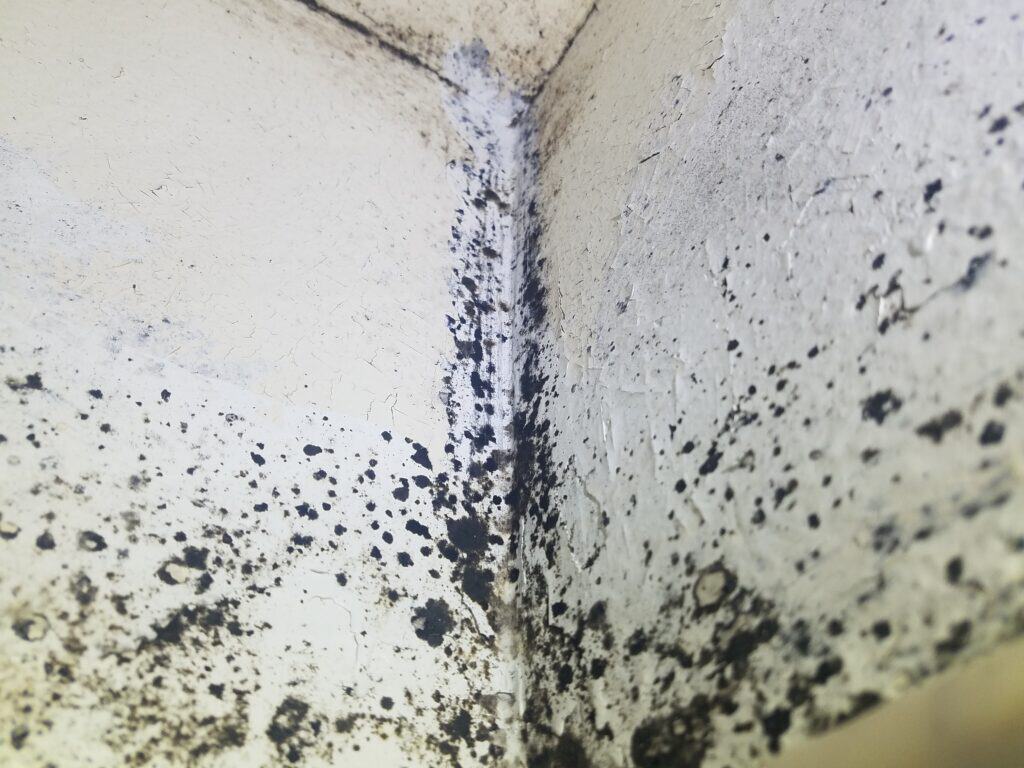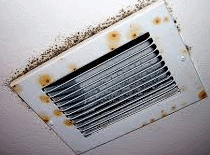
Have you ever noticed those pesky water droplets or fogging on your windows, especially during colder seasons? That’s condensation, and while it may seem harmless, it can signify a more serious problem: mold growth. Condensation can create the perfect breeding ground for mold spores, potentially affecting your indoor air quality and even your health.
Mold thrives in damp environments, and condensation provides a steady supply of moisture. Left unchecked, mold can spread rapidly, causing unsightly spots and musty odors. In some cases, it can even lead to respiratory problems and other health issues.
Don’t let condensation pave the way for mold in your home. In this blog post, we’ll uncover how condensation leads to mold growth and, most importantly, how you can take steps to protect your home and your well-being.
The Three Ingredients Needed for Mold Growth
Imagine mold spores as uninvited guests at a party. They wouldn’t crash just any gathering. They’d seek out a place with the perfect party favors to fuel their mischief. Mold growth is similar. To thrive, it needs specific conditions to set up shop in your home.
- Food: Mold feeds on cellulose-based materials like wood framing, drywall, and carpeting. Basically, mold can get sustenance from anything made from plant materials. It can also thrive on dust and dirt layers on other surfaces like concrete flooring.
- Ideal climate: The indoor conditions of most homes are ideal for mold to thrive – temperatures between 70 and 80 degrees Fahrenheit with no significant draft (airflow). Drafty or well-ventilated areas are less inviting, as spores can’t easily settle. Good ventilation also reduces moisture, another ingredient needed for mold to thrive.
- Moisture: This is where condensation comes in. Mold requires moisture for survival and growth. Sources can range from obvious leaks and spills to subtle humidity in the air. When humid air comes into contact with cooler surfaces, like your windows, it often condenses into liquid water, providing mold with the perfect drink to accompany its meal.
The Science Behind Condensation and Mold Growth
Ever wonder how those water droplets appear on your windows? It is due to a scientific concept called condensation.
Condensation is all about air temperature and its ability to hold moisture. Picture air as a sponge – warmer air acts like a bigger sponge, holding more water vapor. However, when this warm, moisture-laden air hits a cold surface like your windows in winter, it cools down. Like squeezing a sponge, the air releases some of that moisture, forming water droplets right on the glass.
Now, let’s bring mold into the picture.
Mold spores are tiny hitchhikers, floating around in the air and always on the lookout for a cozy place to settle. That seemingly harmless condensation on your windows is the ideal spa for those spores. Moisture, as we learned, is a key ingredient in mold’s recipe for growth, and condensation provides a steady supply.
Key takeaway: Condensation isn’t just an annoyance – it’s a potential invitation for mold to start its own indoor party. By understanding condensation, we can take targeted steps to keep our homes mold-free.
Signs of Condensation And Mold Growth
Water droplets on your windowpanes are the most obvious signs of condensation and, by extension, high humidity. Other clues include:
- Fogging: Window panes appear hazy or cloudy even when the weather is not foggy.
- Visible mildew or mold: Patches of green or black growth, especially at the edges of your windows and on the window sills.
Remember, condensation itself isn’t mold. However, it creates a good environment for mold to start growing. Think of it as a warning sign to start taking action before you have a full-blown mold problem.
Humidity Hotspots: Where Condensation Thrives
Understanding humidity is key to battling condensation and preventing mold. Humidity refers to the amount of moisture (water vapor) in the air. The warmer the air, the more moisture it can hold. When this warm, humid air encounters a colder surface (like those windows on a chilly day), condensation happens.
Here’s the problem: some areas of your home are naturally breeding grounds for high humidity. Let’s take a look at the common suspects:
- Bathrooms:Showers and baths release a lot of steam, drastically increasing humidity. If your bathroom lacks proper ventilation, those water droplets on the mirror quickly become a potential mold paradise.
- Kitchens:From boiling water to running the dishwasher, kitchens generate plenty of moisture. Limited airflow can make this a prime spot for condensation-related issues.
- Basements:Basements often have cooler temperatures and can be prone to dampness from surrounding soil or poor sealing. This creates ideal high-humidity conditions for mold growth.
- Laundry Rooms:Wet clothes and running appliances add moisture to the air. Ventilation is key to combating potential condensation and mold problems in this space.
By identifying these humidity hotspots, you can focus your efforts on controlling moisture in these areas, reducing the risk of condensation, and keeping mold at bay.
The Importance Of Ventilation In Preventing Condensation
Effective ventilation plays a crucial role in preventing condensation. Ventilation gets rid of excess moisture in your indoor air and is particularly important in areas with high humidity, such as bathrooms and kitchens.
Here’s a closer look at how ventilation helps prevent condensation and mold growth:
- Less moisture: Proper ventilation whisks away excess moisture, especially from humidity hotspots like bathrooms and kitchens. It’s like opening a window for that humid air, letting it escape before it can settle on your windows and walls.
- Prevents mold spores from settling: A steady flow of air makes it harder for those pesky mold spores to settle and grow on surfaces in your home.
- A balanced environment: Ventilation helps keep the overall temperature inside your home balanced. Drastic swings between warm temperatures and cold allow moisture in the air to condense and form water.
Here are simple and effective tactics to keep your home ventilated:
- Open Windows:Especially during high-humidity activities like cooking or showering. Even a small opening promotes healthy airflow.
- Exhaust Fans:Your bathroom and kitchen’s best friends! Run them during and after activities that produce steam.
- Dehumidifiers:A helpful tool for chronically damp areas like basements. It reduces overall moisture levels.
Good ventilation is the most effective way to prevent condensation and create a less inviting environment for mold growth.
How Insulation Impacts Condensation and Mold Growth
You might think insulation is just about keeping your home cozy, but it surprisingly plays a role in condensation and mold risk. Here’s the breakdown:
- Older Homes vs. Newer Homes: Older homes with less insulation are more likely to have ‘cold spots’ on walls, inside cabinets, etc. When warm, humid indoor air hits those spots, condensation happens more easily. Newer, well-insulated homes have fewer of these cold spots, but they also tend to trap moisture inside more effectively.
- The Ventilation Factor: Insulation is great, but without adequate ventilation, humidity builds up in a well-insulated home. That trapped humidity seeks out cooler surfaces (like your windows!) to condense on, creating mold’s ideal environment.
- Insulation Types Matter: Different materials (foam, blown-in, etc.) offer varying levels of thermal protection and moisture control. Gaps or poor installation of insulation can also create areas for condensation.
Insulation plays a complex role in regulating temperature and humidity within your home. It is essential but needs to be balanced with proper ventilation. Whether your home is older or newer, understanding the link between insulation, condensation, and airflow is crucial in preventing mold problems.
Additional Strategies to Reduce Condensation
While proper ventilation is crucial, there’s more you can do to minimize condensation and keep your home mold-free. Here are some extra tactics to add to your arsenal:
Control Humidity Sources
- Use lids when cooking to reduce steam release.
- Hang wet laundry outdoors or in a well-ventilated area.
- Avoid overwatering houseplants–excess water evaporates, increasing humidity.
- Address plumbing leaks and spills promptly.
Improve Air Circulation
- Run ceiling fans to prevent air stagnation.
- Leave space between furniture and walls for airflow, especially around windows.
- Open closet and interior doors occasionally, especially in less-used rooms.
Adjust Indoor Temperature
- During colder months, a slight decrease in your thermostat can minimize the temperature difference between warm indoor air and cooler windows.
- Avoid drastic temperature swings, which can trigger condensation.
Invest in a Dehumidifier
- Consider a dehumidifier for chronically damp areas like basements or rooms where ventilation is limited. Dehumidifiers can help remove excess moisture from the air, reducing condensation and creating a less hospitable environment for mold growth.
Consider Window Upgrades
- Double or triple-pane windows provide better insulation, minimizing the risk of condensation.
Final Thoughts
Despite your best efforts, condensation or even mold growth can still happen. The most important thing is not to ignore it. If you notice persistent condensation in the same spot, take measures to improve ventilation, reduce humidity, and improve insulation.
Condensation is a warning sign of excess moisture in the air in your home, which creates good conditions for mold to thrive. If you ignore it, you might find yourself with a huge mold problem. If there is already visible mold or musty odors, you might want to consider professional mold removal.

